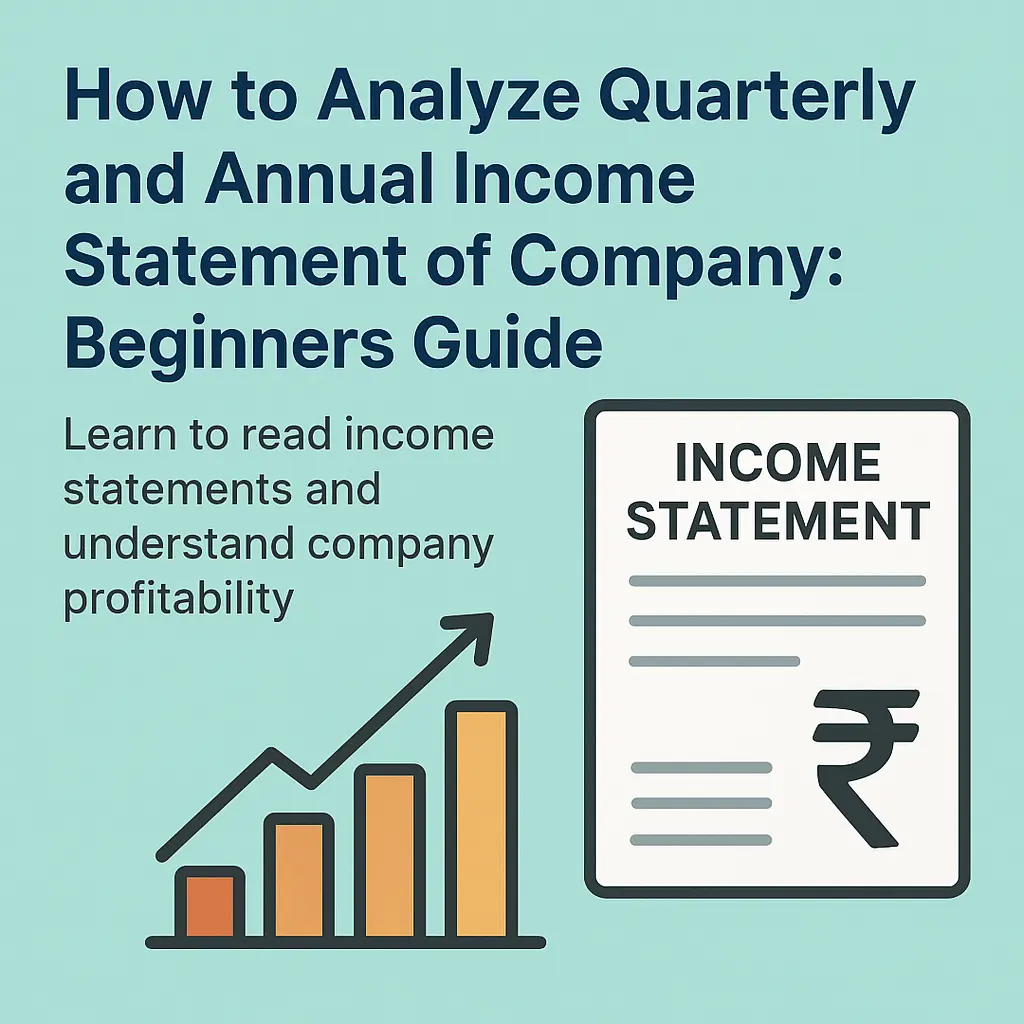

Why the Income Statement is Your Profitability Compass
The income statement, also known as the profit and loss statement, is arguably the most watched financial statement by investors. It tells you how much money a company made, how much it spent, and what's left as profit over a specific period.
While the balance sheet shows financial position at a point in time and the cash flow statement shows cash movements, the income statement reveals the operating performance and profitability of a business.
Simple Analogy: Think of your personal finances - your monthly budget showing income (salary), expenses (rent, food, bills), and savings (what's left) is like a personal income statement. The company version just has more categories and follows accounting rules.
Quarterly vs Annual Income Statements: Key Differences
| Aspect | Quarterly Statement | Annual Statement |
|---|---|---|
| Time Period | 3 months | 12 months |
| Frequency | 4 times per year | Once per year |
| Audit Status | Usually unaudited | Audited by independent auditors |
| Purpose | Track short-term performance | Assess full-year performance |
| Seasonality Impact | High - shows quarterly variations | Low - smooths out seasonal effects |
| Detail Level | Less detailed | More detailed with footnotes |
Pro Tip: Always analyze both quarterly and annual statements together. Quarterly statements help you spot trends and seasonality, while annual statements give you the complete picture and are more reliable due to auditing.
The Income Statement Line by Line: What Each Item Means
This is the top line of the income statement and represents the total amount of money generated from selling goods or services.
What to look for:
- Is revenue growing consistently?
- How does growth compare to previous periods?
- Is growth coming from volume or price increases?
Example: A software company showing ₹500 crores in revenue means they generated this amount from software sales and services during the period.
These are the direct costs associated with producing the goods or services sold. For manufacturers, this includes raw materials and labor. For retailers, it's the purchase cost of inventory.
What to look for:
- Is COGS growing slower than revenue? (Good sign)
- Are there any sudden spikes in COGS? (Investigate why)
This is what remains after subtracting COGS from revenue. It shows how efficiently the company produces its goods or services.
Gross Profit = Revenue - Cost of Goods Sold
What to look for: Consistent or improving gross profit indicates good cost control and pricing power.
These are expenses required to run the business but not directly tied to production. Major categories include:
- SG&A (Selling, General & Administrative): Salaries, marketing, office expenses
- R&D (Research & Development): Product development costs
- Depreciation & Amortization: Non-cash expense for asset usage
What to look for: Operating expenses should not grow faster than revenue in a well-managed company.
Also called EBIT (Earnings Before Interest and Taxes), this shows profitability from core operations before financing and tax effects.
Operating Profit = Gross Profit - Operating Expenses
What to look for: This is a key indicator of business efficiency. Growing operating profit is a very positive sign.
This is what remains after all expenses, including taxes and interest, are deducted from revenue. It's the amount that can be reinvested or distributed to shareholders.
Net Profit = Operating Profit - Interest - Taxes + Other Income
What to look for: Consistent growth in net profit is what ultimately drives stock prices higher.
Sample Income Statement: Understanding with Example
Let's look at a simplified income statement for "ABC Manufacturing Ltd" for the year ended March 31, 2025:
| ABC Manufacturing Ltd | |
|---|---|
| Income Statement for Year Ended March 31, 2025 (Amounts in ₹ Crores) | |
| Revenue from Operations | 1,000 |
| Other Income | 20 |
| Total Revenue | 1,020 |
| Cost of Materials Consumed | (550) |
| Employee Benefit Expenses | (150) |
| Other Expenses | (50) |
| Total Expenses | (750) |
| Gross Profit | 270 |
| Selling & Distribution Expenses | (40) |
| Administrative Expenses | (30) |
| Total Operating Expenses | (70) |
| Operating Profit (EBIT) | 200 |
| Interest Expense | (25) |
| Depreciation | (30) |
| Profit Before Tax (PBT) | 145 |
| Tax Expense | (40) |
| Net Profit | 105 |
| Number of Shares (in crores) | 10 |
| Earnings Per Share (EPS) | ₹10.5 |
Key Takeaways from this example:
- Revenue of ₹1,000 crores with net profit of ₹105 crores - 10.5% net margin
- Gross profit margin: 270/1000 = 27%
- Operating profit margin: 200/1000 = 20%
- Healthy EPS of ₹10.5 per share
- Interest expense of ₹25 crores is manageable relative to operating profit
Key Income Statement Ratios Every Investor Should Master
Formula: (Gross Profit ÷ Revenue) × 100
What it tells you: Production efficiency and pricing power
ABC Company: (270 ÷ 1000) × 100 = 27%
Good range: Varies by industry, but stable/improving is key
Formula: (Operating Profit ÷ Revenue) × 100
What it tells you: Overall operational efficiency
ABC Company: (200 ÷ 1000) × 100 = 20%
Good range: Higher is better, compare with industry
Formula: (Net Profit ÷ Revenue) × 100
What it tells you: Overall profitability after all expenses
ABC Company: (105 ÷ 1000) × 100 = 10.5%
Good range: Varies widely by industry
Formula: Net Profit ÷ Number of Shares
What it tells you: How much profit each share earns
ABC Company: 105 ÷ 10 = ₹10.5 per share
What to look for: Consistent growth over time
Step-by-Step Guide to Analyzing Any Income Statement
Step 1: Start with Revenue Analysis
Revenue is the starting point of all profitability. Ask these questions:
- Is revenue growing? At what rate?
- Is growth accelerating or decelerating?
- How does growth compare to industry and competitors?
- Are there any one-time revenue items distorting the picture?
Step 2: Examine Profit Margins
Calculate and analyze all three key margins:
Gross Margin = (Gross Profit ÷ Revenue) × 100
Operating Margin = (Operating Profit ÷ Revenue) × 100
Net Margin = (Net Profit ÷ Revenue) × 100
- Are margins stable or improving?
- How do they compare to historical levels?
- How do they compare to industry averages?
- Is there a big gap between operating and net margin? (Could indicate high interest or taxes)
Step 3: Analyze Expense Management
Look at how efficiently the company manages costs:
- Are operating expenses growing faster than revenue? (Red flag)
- What percentage of revenue goes to each expense category?
- Are there any unusual or one-time expenses?
- Is the company investing adequately in R&D for future growth?
Step 4: Calculate and Interpret EPS
Earnings Per Share is what ultimately matters for shareholders:
EPS = Net Profit ÷ Number of Outstanding Shares
- Is EPS growing consistently?
- How does EPS growth compare to revenue growth?
- Are there any share buybacks boosting EPS artificially?
Step 5: Compare Quarterly and Annual Trends
Look at the big picture by analyzing multiple periods:
- Compare current quarter with same quarter previous year (YoY)
- Compare sequential quarters (QoQ)
- Look at full-year trends over 3-5 years
- Identify any seasonality patterns
💡 Professional Analyst Insight
Always look for companies with the "profitability trifecta": 1) Consistent revenue growth, 2) Stable or expanding profit margins, and 3) Growing EPS. Companies that demonstrate all three characteristics over multiple years are typically high-quality businesses worth further investigation.
Understanding Quarterly Income Statement Patterns
Quarterly statements often show patterns that annual statements smooth out. Here are common patterns to recognize:
📈 Consistent Growth Pattern
Characteristics: Revenue and profits grow each quarter compared to same quarter previous year
Example Quarters: Q1: +15%, Q2: +18%, Q3: +16%, Q4: +17%
Interpretation: Strong, sustainable business with predictable growth
🌞 Seasonal Business Pattern
Characteristics: Certain quarters consistently stronger than others
Example: Q4 much stronger than Q1 (holiday season effect)
Interpretation: Normal for retail, consumer goods; compare with same quarter previous year
⚠️ Declining Performance Pattern
Characteristics: Successive quarters show slowing growth or declines
Example: Q1: +10%, Q2: +5%, Q3: -2%, Q4: -8%
Interpretation: Business facing challenges; investigate causes
Real Company Comparison: What to Look For
Let's compare two fictional companies in the same industry:
| Metric | Quality Co. | Average Co. | Analysis |
|---|---|---|---|
| Revenue Growth (3-yr avg) | 18% | 8% | Quality Co. growing much faster |
| Gross Margin | 45% | 32% | Quality Co. has better pricing power |
| Operating Margin | 22% | 14% | Quality Co. more efficient operationally |
| Net Margin | 16% | 9% | Quality Co. keeps more of each revenue rupee |
| EPS Growth (3-yr avg) | 20% | 7% | Quality Co. creating more shareholder value |
| Expense/Revenue Ratio | 78% | 86% | Quality Co. manages expenses better |
Based on this analysis, Quality Co. is clearly the superior business.
Common Income Statement Mistakes to Avoid
⚠️ Common Beginner Mistakes
- Focusing only on net profit: Ignoring revenue growth and margins
- Not adjusting for one-time items: Taking reported numbers at face value
- Ignoring quarterly trends: Only looking at annual statements
- Overlooking seasonality: Comparing wrong quarters
- Not reading footnotes: Missing important explanations
- Industry blindness: Comparing margins across different industries
- Ignoring EPS dilution: Not accounting for new share issues
Income Statement vs. Other Financial Statements
Understanding how the income statement connects with other statements is crucial for complete analysis:
| Financial Statement | What It Shows | Connection to Income Statement |
|---|---|---|
| Income Statement | Profitability over time | Shows revenue, expenses, and profits |
| Balance Sheet | Financial position at a point | Net profit flows to retained earnings in equity |
| Cash Flow Statement | Cash movements over time | Net income is starting point for operating cash flow |
Remember: The income statement uses accrual accounting (records revenue when earned, not when cash received), which is why it differs from the cash flow statement. Always analyze all three statements together for a complete picture.
Where to Find Income Statements
As an investor, you can access income statements through multiple sources:
Investor relations sections contain quarterly and annual reports with complete financial statements.
MoneyControl, Screener.in, Yahoo Finance, and Trendlyne provide income statements with ratios.
BSE and NSE websites have corporate filings including quarterly and annual results.
SEBI database and company annual reports filed with regulators contain audited statements.
Your Quick Income Statement Analysis Checklist
✅ Income Statement Health Checklist
- Revenue growing consistently (quarterly and annually)
- Stable or improving gross, operating, and net margins
- EPS growing consistently over multiple periods
- Operating expenses not growing faster than revenue
- No significant one-time items distorting performance
- Profit margins comparable or better than industry peers
- Interest expense manageable relative to operating profit
- Tax rate consistent and reasonable
Final Thoughts for Beginners
Mastering income statement analysis will transform your ability to identify quality companies. Remember these key principles:
- Revenue growth is the engine - without growing sales, profit growth is limited
- Margins reveal efficiency - how well the company converts revenue to profit
- EPS is what matters to shareholders - growing EPS drives stock prices
- Look for consistency across quarters and years
- Always compare with industry peers for context
- Read the notes and management discussion for important details
With practice, you'll be able to quickly assess a company's profitability trends and spot both opportunities and red flags in income statements.
Next Steps: Practice analyzing income statements of companies you're interested in. Start with simple businesses with clear revenue models, then gradually move to more complex companies. Compare 3-5 years of data to identify long-term trends.
Other Financial Articles


How to Analyze Cash Flow Statement of a Company: Beginners Guide
